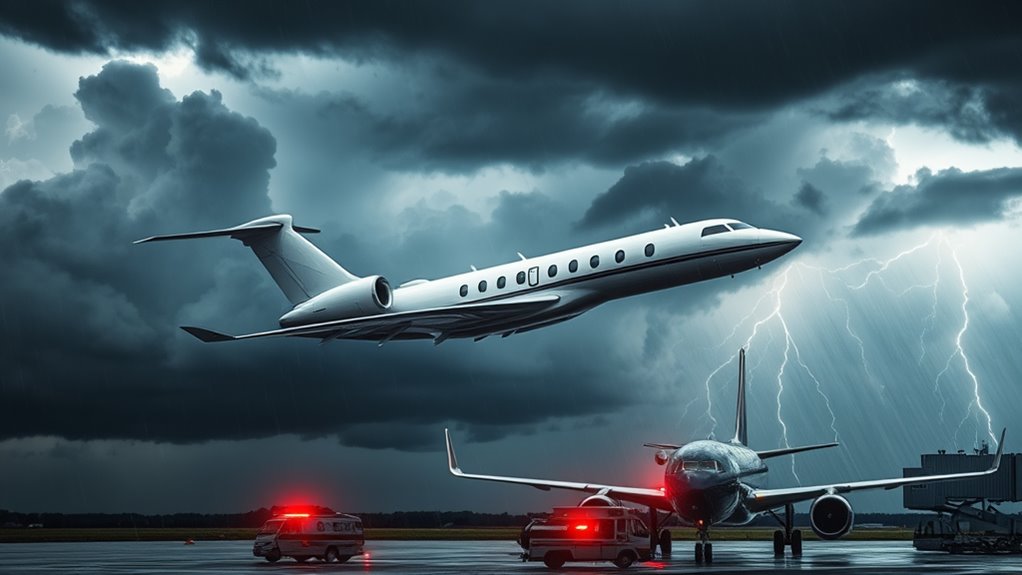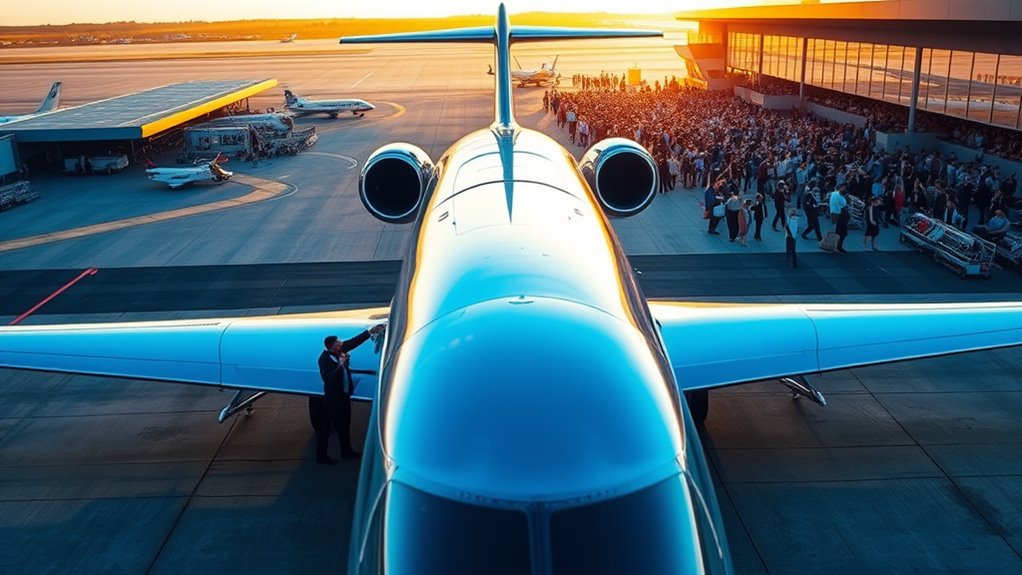In terms of flying, you might think commercial airlines are the gold standard for safety. But hold on a second! Private jets often have an edge that’s worth considering. They follow strict safety standards and have lower accident rates. Plus, flying higher means dodging bad weather. Curious about how these factors stack up? You might be surprised by what you find. Let’s break it down and see which option truly takes the crown for safety in the skies.
Safety Standards and Regulations
When you think about flying, you might wonder about safety. Private jet safety is often better than you think.
All private jet providers in the U.S. are FAA certified, which means they meet strict FAA regulations. These planes undergo annual safety inspections and routine maintenance every 100 hours. That’s serious business!
Plus, many operators go above and beyond basic FAA requirements, thanks to third-party groups like ARGUS and WYVERN setting even higher safety standards.
Many private jet operators exceed FAA standards, adhering to even stricter guidelines set by organizations like ARGUS and WYVERN.
You’ll be glad to know the accident rates for corporate flights in private aviation are lower than those for commercial airlines. With only 0.07 accidents per 100,000 hours, private jets really shine in safety. Additionally, private jet operators often focus on proactive risk management, which enhances overall safety and emergency preparedness.
Passenger Environment and Control
Flying private isn’t just about luxury; it’s also about the passenger environment and control. Private jets are safer for a reason. With an average of just four passengers, you’re dodging those pesky health risks present on crowded commercial flights.
You’ll enjoy the privacy that comes from using exclusive private terminals, streamlining security processes and keeping interactions minimal. Plus, you know who you’re flying with, which cuts down on disruptive behavior.
The controlled environment guarantees high-quality hygiene standards, with continuous air filtration to keep things fresh. And let’s not forget the crew familiarity! They know your needs, providing tailored care that makes your experience not just safe but enjoyable.
Why settle for less?
Emergency Landing and Weather Adaptability

Imagine you’re on a private jet, and suddenly, the weather turns sketchy. You might be wondering how safe you really are. Here’s the deal:
- More Options: Private jets can land at thousands of smaller airports across the country, giving you more emergency landing choices than commercial airlines.
- Higher Altitude: They typically fly above 40,000 feet, dodging inclement weather and turbulence for a smoother flight experience.
- Flexible Flight Paths: With the adaptability of private jets, pilots can change routes and avoid storms, making them safer than commercial options.
In those unexpected moments, you’ll appreciate how private jets prioritize safety. They can reach speeds of up to 600 miles per hour, allowing for quicker responses in emergencies. They don’t rush to get you there, which means fewer risks. It’s all about comfort and security in the skies!
Pilot Experience and Training
Pilot experience and training are crucial elements in guaranteeing your safety while traveling on a private jet. Unlike commercial flights, private jet pilots undergo extensive model-specific training and adhere to strict FAA regulations. These regulations guarantee that they meet high standards, including duty limitations.
Most private jets require two pilots, adding an extra layer of safety and experience. Private charter operators maintain rigorous hiring practices, so you know your pilots are experienced.
While airline pilots log around 1,500 hours for certification, private jet pilots also benefit from continuous training. This prepares them for diverse operational challenges, enhancing overall flight safety.
Security Measures and Maintenance

When you step aboard a private jet, you’re stepping into a world where security and maintenance are taken very seriously.
Private jet companies prioritize your safety, going above and beyond FAA safety standards. Here’s how they do it:
- Controlled Access: Only authorized personnel and familiar passengers get near the aircraft, greatly reducing security risks.
- Third-Party Certifications: Many private jets hold certifications like ARGUS, ensuring they pass rigorous safety audits.
- Routine Inspections: Regular maintenance checks and inspections keep the jets in top shape, often better than older commercial fleets. Additionally, all aircraft comply with strict noise and emissions standards, ensuring environmental safety as well.
Health and Safety Considerations
Private jets aren’t just about luxury; they offer a safer and healthier travel experience too.
With an average of just four passengers, you face fewer health risks from contagious illnesses compared to a packed commercial flight. Plus, private jets have antimicrobial barriers that actively fight against germs and viruses, including Covid-19, keeping your travel environment cleaner.
You’ll also enjoy exclusive terminals that streamline security processes, minimizing your contact with other travelers. Improved cleanliness protocols, like HEPA air filtration and rigorous maintenance, guarantee hygiene levels that surpass those on commercial airlines.
Advantages of Private Jet Travel

Here are three key advantages:
- Lower Accident Rates: Private jets statistically have lower accident rates, making them safer than commercial flights.
- Smoother Flight Experience: With the ability to fly above 40,000 feet, you’ll dodge turbulence and enjoy a more comfortable ride.
- Tailored Safety Attention: A dedicated crew knows your needs, providing personalized service and improved safety measures, like antimicrobial-treated interiors. Additionally, private jets are subject to rigorous maintenance schedules, ensuring they remain in prime condition before each flight.
Plus, you can land at smaller airports, making your travel options more flexible and convenient.
Frequently Asked Questions
Is It Safer Flying Private or Commercial?
When considering safety, private jet safety often benefits from improved pilot training standards and altitude advantages, while commercial airline regulations guarantee strict maintenance protocols. You’ll find flexibility in flight paths and emergency response procedures differ greatly, impacting your general experience.
Do Private Jets Get More Turbulence?
Private jets generally experience less turbulence due to altitude differences, aircraft design, and smaller jet size. Their pilots can adjust flight paths to avoid weather conditions, enhancing passenger comfort and maintaining stable cabin pressure.
Are Commercial Planes Safer Than Small Planes?
In terms of safety, you’re better off with commercial planes. Their robust aircraft maintenance, rigorous pilot training, and strict safety regulations improve passenger experience, while crash statistics and flight technology back their reliability over small planes.
What Is the Safest Commercial Jet to Fly?
When considering the safest commercial jet, look for high safety ratings, rigorous airline regulations, qualified pilots, strict maintenance standards, and advanced flight technology. These factors contribute to your passenger experience, ensuring effective emergency protocols and cabin pressure management.
Conclusion
In the battle of private jets versus commercial airlines, private jets take the crown for safety. With their exceptional safety standards, skilled pilots, and the ability to dodge nasty weather, they’re like flying in a bubble of security. You get fewer people around you, reducing health risks, too! So, if you want a travel experience that feels as safe as wrapping yourself in a security blanket while soaring through the skies, private jets are the way to go!